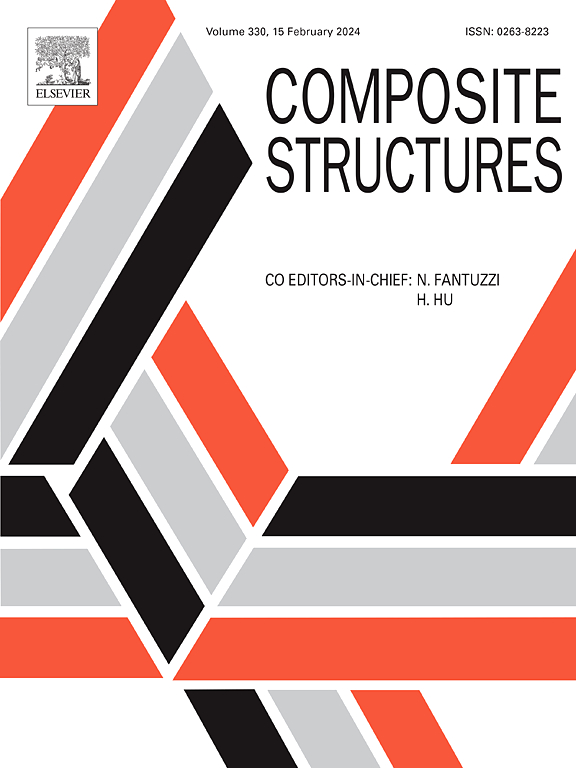Improved mixed gradient design method to enhance compression stiffness and energy absorption of auxetic structures
IF 6.3
2区 材料科学
Q1 MATERIALS SCIENCE, COMPOSITES
引用次数: 0
Abstract
The auxetic structure with multi-plateau stress stages exhibited excellent designability while improving mechanical properties. In this study, a mixed gradient design method was proposed to simultaneously enhance the energy absorption capacity and compression stiffness of auxetic structures. According to the different types of cell-walls, star-triangle honeycombs (STH) with uniform thickness were designed, and in-plane crushing tests were carried out to reveal the deformation and energy absorption characteristics. The reliable finite element models were constructed to systematically reveal the deformation sequence and load-bearing characteristics of different types of cell-walls at different deformation stages. Subsequently, different cell-wall thickness ratios (δ) were constructed according to the load-bearing characteristics of different types of cell-walls. Comparative analysis revealed that the thickness ratio could simultaneously improve the specific energy absorption (SEA) and compression stiffness (E) of STH. Based on the and keeping the re-entrant cell-wall thickness constant, improved single gradient and mixed gradient thickness design methods were proposed. Finally, the improved single gradient design exhibited a significant enhancement effect on the E of STH. Compared with the traditional thickness gradient (STH-UTG), the SEA and E of STH with mixed thickness gradient were improved by about 52.37 % and 193.34 %, respectively. Consequently, the mixed gradient design methods provide innovative insights for enhancing the mechanical properties of auxetic structures.
改进混合梯度设计方法,提高结构抗压刚度和吸能
具有多平台应力阶段的形变结构在提高力学性能的同时具有良好的可设计性。本文提出了一种混合梯度设计方法,以同时提高结构的吸能能力和抗压刚度。针对不同类型的蜂窝壁,设计了厚度均匀的星形三角形蜂窝(STH),并进行了面内破碎试验,揭示了其变形和吸能特性。建立了可靠的有限元模型,系统地揭示了不同类型胞壁在不同变形阶段的变形顺序和承载特性。随后,根据不同类型细胞壁的承载特性构建不同的细胞壁厚度比(δ)。对比分析表明,厚度比δ2=t2/t1=t3可以同时提高STH的比能吸收(SEA)和抗压刚度(E),在δ2的基础上,在保持重入胞壁厚度不变的情况下,提出了改进的单梯度和混合梯度厚度设计方法。最后,改进的单一梯度设计对STH的E有显著的增强作用,与传统的厚度梯度(STH- utg)相比,混合厚度梯度的STH的SEA和E分别提高了52.37%和193.34%。因此,混合梯度设计方法为提高结构的力学性能提供了创新的见解。
本文章由计算机程序翻译,如有差异,请以英文原文为准。
求助全文
约1分钟内获得全文
求助全文
来源期刊

Composite Structures
工程技术-材料科学:复合
CiteScore
12.00
自引率
12.70%
发文量
1246
审稿时长
78 days
期刊介绍:
The past few decades have seen outstanding advances in the use of composite materials in structural applications. There can be little doubt that, within engineering circles, composites have revolutionised traditional design concepts and made possible an unparalleled range of new and exciting possibilities as viable materials for construction. Composite Structures, an International Journal, disseminates knowledge between users, manufacturers, designers and researchers involved in structures or structural components manufactured using composite materials.
The journal publishes papers which contribute to knowledge in the use of composite materials in engineering structures. Papers deal with design, research and development studies, experimental investigations, theoretical analysis and fabrication techniques relevant to the application of composites in load-bearing components for assemblies, ranging from individual components such as plates and shells to complete composite structures.
 求助内容:
求助内容: 应助结果提醒方式:
应助结果提醒方式:


